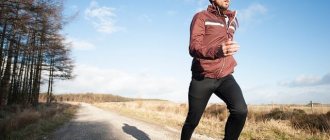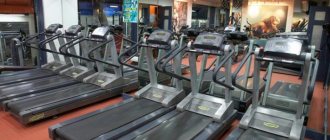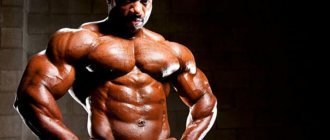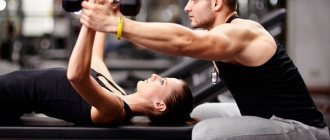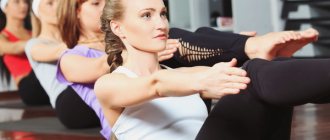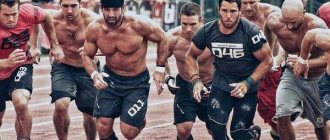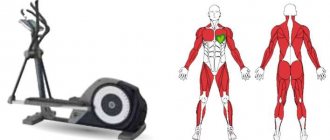List of effective physical exercises for body tightening at home
The course of classes should be divided into blocks: warm-up, cardio, main and final (stretching). The central place will be occupied by basic and insulating elements. To increase muscle mass and definition, beginners should start with a strength “base”. More experienced athletes can add 2-3 isolation exercises to their training.
Basic power
“Base” is the basis of any complex, no matter what we are talking about: strength, mass, relief or weight loss. These exercises load several muscle groups at once and involve at least 2 joints.
Strength elements are activities in which the role of additional sports equipment is played by equipment (dumbbells, barbells), exercise equipment or your own body weight.
Basic strength training must be included in your home training program.
- Push-ups.
Technique:
- take a “lying” position with support on your toes and palms;
- tighten your abs and buttocks (the body is straight);
- while inhaling, slowly lower until your chest touches the floor;
- rise sharply and exhale.
Beginners can start doing push-ups from their knees or from a wall, progressing in intensity over time.
- Bent-over dumbbell raises.
One of the most popular strength exercises at home among both men and women.
Technique:
- bend over until your torso is parallel to the floor;
- lower your hands with the shells down, slightly bending your knees;
- as you exhale, smoothly spread your arms to the sides;
- while inhaling, slowly return to IP.
Subtleties: the position of the body changes depending on the load on the muscles, the arms work with a bend in the elbow joints.
- Lunges.
Technique:
- stand up straight with your arms at your sides;
- draw in your stomach, looking forward, without lowering your head and body, while exhaling, take a wide step forward with your left leg, slightly bending the back one at the knee;
- transfer your weight to your leading leg and hold for 2 seconds without your knee going over your toes;
- while inhaling, smoothly return back;
- repeat with the other leg.
Attention! Features: the knee that comes forward should form a right angle in the joint, the back leg is only a support to maintain balance, only the leading limb works.
- Pull-up.
Technique:
- fixate on the bar, positioning your hands with the desired grip;
- cross your legs and tense your abdominal muscles;
- slowly raise your body until your chin crosses the border of the crossbar;
- hold for 1-2 seconds;
- quickly return to IP.
This basic exercise varies depending on the type of grip. You can connect weights.
| Name | What muscles work | Number of sets | Number of repetitions |
| Push-up | External pectoral and triceps | 3 | 10-12 |
| Dumbbell flyes | Posterior deltas | 3-4 | 10-12 |
| Lunges | Muscles of the buttocks, abs, thighs and calves | 3-4 | 15-20 |
| Pull-up | Latissimus, shoulders, biceps, triceps | 3-5 | 10-15 |
All exercises require fixation for 1-2 seconds at the peak point or effort.
Cardio
Cardio exercise has many facets. They are included in training programs for both home and gym. These elements help prepare the body for stress, burn extra calories, train breathing, and strengthen muscle tissue:
- Run.
Presented in the form of a classic morning jog or run up the stairs. The latter is more effective. You can do a similar workout every morning for 25-30 minutes.
- Jumping rope.
The favorite pastime of Soviet schoolgirls actually turned out to be an excellent prevention of heart disease and a means of achieving a thin waist. In addition to increasing blood flow and heart rate, jumping can reduce fat in the abdominal area and strengthen the leg muscles. Performed for 8-25 minutes at a medium-fast pace.
- Climber.
Element with very high efficiency. It develops both the strength and power of the athlete, improves joint mobility, loads the hip, gluteal and calf muscles, abdominal muscles and quadriceps, and also burns a large amount of calories. Beginners perform it slowly, more experienced athletes perform it dynamically.
Stretch
Stretching (1) is a necessary stage of preparation for a home workout. It accelerates blood flow, thereby improving intercellular exchange, increases the elasticity of ligaments and joint mobility. The most popular are power and static types of warming up.
Warming up with weights involves working with light loads and high repetitions. Another condition for its productivity is complete stretching of the muscles on the elements.
Most often used for heating:
- dumbbell fly;
- pullover;
- French press;
- lifting the barbell from the chest.
They work with small dumbbells and an empty bar.
Static heating is more in demand. Some of its elements are familiar from school physical education lessons:
- body rotation;
- bending to the sides and back and forth;
- hanging on the bar;
- bending the knee with the heel to the buttock (quadriceps stretch);
- leg extension with emphasis on the straight knee (femoral biceps);
- bridge;
- boat.
The main principle is maximum stretching to the point of greatest discomfort with fixation for 20-30 seconds.
Be sure to check out:
Gallery image with caption: Exercises with dumbbells at home for women Gallery image with caption: How to build muscles at home: effective exercises for creating an athletic body Gallery image with caption: Shaping programs for losing excess weight at home Gallery image with caption: Exercises for an ideal figure at home: a beautiful athletic figure at home
Self-study tools
The most common
means of independent exercise are walking, running, cross-country, swimming, rhythmic and athletic gymnastics, sports games, and training on exercise machines.
Walking improves the body's metabolism and activates the activity of the cardiovascular, respiratory and other systems. The effectiveness of walking on a person depends on the length of the step, the speed of walking and its duration.
When determining physical activity, one should take into account heart rate, which is calculated during short stops while walking and immediately after the end of the workout. When finishing your training walk, you need to gradually reduce the speed so that 8-10 minutes after finishing, your heart rate returns to its original value. The increase in walking distance and speed should increase gradually.
Running is the most effective means of improving health and increasing the level of physical fitness. Beginning runners can alternate between walking and running as a preparation. For example, 50 m running and 150 m walking, then 100 m running and 100 m walking. The running distances should increase involuntarily, naturally, until the running becomes continuous.
When starting a run, it is important to comply with the following condition: the running pace should be low and uniform. You can regulate the intensity of the load based on your heart rate. When running, it should not exceed 180 beats/min minus age. A prerequisite is that classes take place all year round. Training sessions in winter help harden the body and increase its resistance to colds and infectious diseases. To improve health and maintain good physical fitness, it is enough to run every day for 20-30 minutes.
Cross -country is running in natural conditions over rough terrain, overcoming climbs, descents, ditches and other obstacles. It instills the ability to navigate, move long distances across unfamiliar terrain, overcome natural obstacles, and the ability to correctly distribute and evaluate one’s strengths. The place for classes can be a forest park or a park. To determine the volume and intensity of physical activity, you can use running recommendations.
Swimming. Swimming and water games cause positive changes in the functions of the nervous, respiratory, cardiovascular, and digestive systems. In the initial period of training, it is necessary to gradually increase the time spent in the water, aim to overcome a distance of 600–700 meters in the first five days, 700–800 meters in the second, and then 1000–1200 meters.
For those who are poor swimmers, you should first swim a distance of 25, 50 or 100 meters, but repeat it 8 to 10 times.
Recreational swimming is carried out with moderate intensity. Heart rate immediately after swimming the distance for ages 17–30 years should be in the range of 120–150 beats/min. Walking and cross-country skiing .
It is useful to practice skiing every day for at least one hour. The minimum number of classes that gives a healing effect and increases the body’s fitness is three times a week for 1 – 1.5 hours or more at moderate intensity. Heart rate when skiing should not exceed 160 beats/min. Rhythmic gymnastics is a set of simple general developmental exercises that are performed without pauses or rest while listening to music. Due to the fast pace and duration of classes (from 15 to 60 minutes), rhythmic gymnastics has an effect on the musculoskeletal system, the cardiovascular system, and the respiratory system.
In terms of its effect on the body, it can be compared with such cyclic exercises as running and walking. Hence the second name - aerobics (“aero” - air, “bios” - life). Depending on the tasks to be solved, rhythmic gymnastics complexes can be composed in different directions. Having a set of ordinary gymnastic exercises, everyone can independently create a complex for themselves.
Athletic gymnastics is a system of physical exercises that develop strength, combined with versatile physical training. Athletic gymnastics classes develop strength, endurance, agility, and form a harmonious physique. After warming up, a complex of athletic gymnastics is performed, which includes exercises for the shoulder girdle and arms, torso and neck, and for the leg muscles. Using exercises, you can achieve a slender, proportionally developed physique, increase or decrease body weight.
Sports and outdoor games are of great health value. They are distinguished by a variety of motor activities and positive emotions, they effectively relieve fatigue, tone the nervous system, and increase mental and physical performance. The most common sports games are: volleyball, basketball, football, tennis.
Weekend hikes . The organizational center for weekend trips in educational institutions is the tourist section or sports club. Before the hike, the entire group studies the features of the route, the terrain, and natural obstacles. Tourist clothing must be suitable for weather conditions, light and durable. A one-day hike is designed for 6 – 7 hours. The first stop is made 15 - 20 minutes after the start of movement to adjust the equipment, then every 45 minutes.
Exercise classes. Exercise machines are used as a complement to traditional physical exercise. They are used to prevent physical inactivity and hypokinesia, selectively affect various parts of the body, muscle groups, cardiovascular system, strengthen and promote their development.
https://youtu.be/CSXGUx6ljQU
Complex loads on all muscle groups
When developing a home exercise schedule, it's a good idea to start with a weekly plan. After the first few lessons, it will be clear in which direction to make changes and whether it is worth introducing something new.
For newbies
A comprehensive program for beginners should include a base, warm-up and final stretching. A four-day workout involves rest in the middle of the week (Wednesday) and the weekend (Saturday, Sunday).
The Beginner Plan includes:
- Warm up:
- rotation of joints (shoulders, elbows, hands, knees, feet);
- jumping rope – 2-3 minutes;
- burpees – 20-30 times.
- Power block.
- Final stretching (stretching as you exhale, lowering your body as you inhale).
The basis is a strength block (Monday, Thursday) and circuit training (Tuesday, Friday). Elements of the latter are performed for 20-30 seconds with a 10-second rest between circles.
| Monday | Tuesday (2 laps of 20 seconds) | Thursday | Friday (2 laps of 30 seconds) | |
| 1. | Push-ups – 3/8-10 | Burpee | Push-ups – 3/8-10 | Push ups |
| 2. | Bent-over dumbbell row – 3/8-10 | Rock climber | Standing dumbbell fly – 3/8-10 | Burpee |
| 3. | Lifting the body (press) – 3/10 | Jump Squat | Lunges – 3/10-12 | Squat |
| 4. | Dumbbell row up – 3/8-10 | Push ups | Leg raises for lower abs – 3/10 | Rock climber |
| 5. | Plank – 30 seconds | Plank | Plank – 30 seconds | Plank |
For experienced
Professionals train 2-3 times a week. Their lesson plan includes a base and some isolation elements. Strength stretching allows you to prepare your muscles for total loads, and cardio will improve the elasticity of the ligaments.
Approximate 1.5-hour program implemented at home:
Day I (arms, shoulders, chest, back)
Dumbbell rows from a lying position – 2-3/6-8.
- Dumbbell lateral raises – 2-3/6-8.
- Overhead press – 2-3/6-8.
- Projectile thrust in an inclined position – 2-3/6-8.
- Push-ups – 2-3/15-20.
Day II (legs, hips, back)
- Weighted squat – 3/12-12.
- Lunges with dumbbells – 3/10-12.
- Deadlift with apparatus – 3/10-12.
- Calf raises with dumbbells – 2/20.
- Sumo deadlift with one apparatus – 3/10-12.
Finally, you need to do muscle stretching for 2-3 minutes to restore breathing and blood circulation.
Planning the volume and intensity of physical exercises taking into account mental training load
Content
Introduction.....……………………………………………………………………………….. 3
Chapter 1. Planning the volume and intensity of physical exercises, taking into account mental training load. Calculation of hours of independent study…….……………………………………………………………………………………… 5
Chapter 2. Self-study management. Determining the goal. Taking into account individual characteristics and extreme work. Adjustment of training plans………………………………………………………… 12
Conclusion………………………………………………………………………………… 20
List of references…………………………………………………………… 22
Introduction
Physical health is the natural state of the body, due to the normal functioning of all its organs and systems. If all organs and systems work well, then the entire human body functions and develops correctly. The formation of man at all stages of his evolutionary development took place in inextricable connection with active muscular activity. The human body develops in constant motion. Movement is necessary, like food and sleep. Lack of food and sleep is captured by the body, causing a whole range of painful sensations. Motor impairment goes completely unnoticed, and is often accompanied by even a feeling of comfort. With a lack of physical activity, the body's resistance to colds and the action of pathogens decreases.
Introducing students to physical education is an important component in the formation of a healthy lifestyle. Along with the widespread development and further improvement of organized forms of physical education, independent physical exercise is of decisive importance. Modern complex living conditions dictate higher demands on human biological and social capabilities. The comprehensive development of people's physical abilities with the help of organized physical activity (physical training) helps to concentrate all the internal resources of the body on achieving the goal, increases efficiency, and improves health.
Systematic use of physical activity, appropriate to gender, age and state of health, is one of the mandatory factors for a healthy lifestyle. Physical activity is a combination of various motor activities performed in everyday life, as well as organized or independent physical education and sports, united by the term “motor activity.” A large number of people engaged in mental activity have limited motor activity.
Since the physical education program at universities does not provide enough time for physical education, independent systematic physical education and sports classes are necessary. And a person should know that for the normal functioning of the body, everyone needs a certain minimum of physical activity. To do this, there are certain methods for selecting a set of independent physical exercises, planning the intensity, and the volume of these exercises.
Chapter 1. Planning the volume and intensity of physical exercises, taking into account mental training load. Calculation of hours of independent study.
Planning of independent studies is carried out by students under the guidance of a teacher in order to clearly determine the sequence of solving problems of mastering the technique of various physical exercises and increasing the level of functional readiness of the body. Planning documents are developed on the basis of the physical education program for university students. It is advisable to develop long-term planning of independent studies for the entire period of study, i.e. for 5 years. Depending on the state of health, medical group, initial level of physical and sports-technical readiness, students can plan to achieve different results over the years of study at the University. This plan reflects the various challenges faced by students enrolled in different medical groups.
Planning independent physical exercises is aimed at achieving a single goal that faces students of all medical groups - maintaining good health, maintaining a high level of physical and mental performance.
A positive result in physical education can only be achieved with many years of continuous training, based on taking into account the patterns of development of the body and the characteristics of the type of activity (type of sport). When planning and conducting multi-year training, the annual training cycle is taken as a basis.
When planning and conducting independent studies, students should take into account that during the period of preparation and passing tests and exams, the intensity and volume of independent studies should be somewhat reduced, giving them in some cases the form of active recreation. When planning independent training sessions over many years, the total training load, changing in waves taking into account the mental stress of training sessions throughout the year, should tend to increase every year. Only under this condition will there be a strengthening of health, an increase in the level of physical fitness, and for those involved in sports, an increase in the state of fitness and the level of sports results.
Multi-year forward planning should include an increase in volume, intensity and overall training load compared to the previous year. For example, if the first year of independent training begins with the initial level of fitness, which we conventionally denote as zero, then it should end at the level of 20-30%. The next year, starting at a level of 20-30% of the training load, will pass at a higher level and end at a level of approximately 60%. Practical experience shows that when playing sports, for example, middle- and long-distance track and field running, during your studies at a university you can go from a beginner to a 1st category athlete and even achieve better results.
There are three main principles that must be adhered to when performing a set of physical exercises:
- Train every other day or at least three times a week.
- Exercise continuously for 20 minutes.
- Exercise vigorously, but watch your breathing.
The Ministry of Health has determined the minimum weekly volume of physical activity for a student - ten hours. We must remember that physical education is not a one-time event, not a Sunday or a monthly event, it is purposeful, strong-willed, regular physical self-education throughout life.
There are three forms of independent physical education:
- Daily morning exercises.
- Daily physical education break.
- Independent physical education, exercise and sports (at least 2-3 times a week). [2]
Each independent physical education training session consists of three parts. The preparatory part (warm-up) is divided into two parts - general warm-up and special. The general warm-up part consists of walking (2-3 minutes), slow running (women - 6-8 minutes, men - 8-12 minutes), general developmental gymnastic exercises for all muscle groups. It is recommended to perform physical exercises, starting with small muscle groups of the arms and shoulder girdle, then moving on to larger muscles of the torso and finishing with exercises for the legs. After a set of physical exercises of a strength nature and stretching, relaxation exercises should be performed. The special part of the warm-up aims to prepare certain muscle groups and the osseous-ligamentous apparatus for the main part of the class and to ensure the neuro-coordination and psychological adjustment of the body for the upcoming exercises in the main part of the class. In the special part of the warm-up, individual elements of basic physical exercises, imitation, special preparatory exercises, and performing the main exercise in parts and as a whole are performed. This takes into account the pace and rhythm of the work ahead. In the main part of the complex of physical exercises, sports technique and tactics are studied, training is carried out, physical and volitional qualities (speed, strength, endurance) are developed. In the final part, slow running (3-8 minutes) is performed, turning into walking (2-6 minutes), and relaxation exercises combined with deep breathing, which ensure a gradual reduction in the training load and bring the body to a relatively calm state.
Morning hygienic exercises are included in the daily routine in the morning hours after waking up from sleep.
Morning hygienic exercises should include exercises for all muscle groups, flexibility exercises and breathing exercises. It is not recommended to perform static exercises, with significant weights, for endurance (for example, long running until fatigue). You can include exercises with a skipping rope, an expander and a rubber band, with a ball (elements of playing volleyball, basketball, football with a light load).
Morning hygienic exercises should be combined with self-massage and hardening of the body. Immediately after performing a complex of morning exercises, it is recommended to do self-massage of the main muscle groups of the legs, torso and arms (5-7 minutes) and perform water procedures, taking into account the rules and principles of hardening.
Exercises during the day are performed in breaks between educational or independent classes. Such exercises prevent fatigue and help maintain high performance for a long time without overexertion. Performing physical exercises for 10-15 minutes every 1-1.5 hours of work has twice the stimulating effect on improving performance than passive rest twice as long.
Physical exercises should be carried out in well-ventilated areas. It is very beneficial to do exercises outdoors.
Independent training sessions can be conducted individually or in a group of 3-5 people or more. Group training is more effective than individual training. It is recommended to exercise 2-7 times a week for 1-1.5 hours. It is not advisable to exercise less than 2 times a week, since this does not help to increase the level of fitness of the body. The best time for training is the second half of the day, 2-3 hours after lunch. You can train at other times, but not earlier than 2 hours after a meal and no later than an hour before a meal or before going to bed. It is not recommended to train in the morning immediately after going to bed on an empty stomach (at this time it is necessary to perform hygienic exercises). Training sessions should be comprehensive, i.e. promote the development of a whole variety of physical qualities, as well as improve health and improve the overall performance of the body. The specialized nature of the occupations, i.e. participation in the chosen sport is allowed only for qualified athletes.
So, if we consider the forms of independent physical education in more detail, we can highlight the following: walking and running, swimming, walking and skiing, cycling, rhythmic gymnastics, athletic gymnastics, training on exercise machines.
Walking and running. Walking is a natural type of movement in which most muscles, ligaments, and joints are involved. Walking improves metabolism in the body and activates the activity of the cardiovascular, respiratory and other body systems. The intensity of physical activity when walking is easily adjusted in accordance with the state of health, physical fitness and fitness of the body. The effectiveness of walking on the human body depends on the length of the step, walking speed and its duration. Before training, you need to do a short warm-up. When determining physical activity, heart rate (pulse) should be taken into account. The pulse is calculated during short stops while walking and immediately after the end of the workout.
The increase in walking distance and speed should increase gradually. If you feel well and freely perform walking training loads, you can move on to alternating running with walking, which ensures a gradual increase in the load and makes it possible to control it in strict accordance with your individual capabilities.
Running is the most effective means of improving health and increasing the level of physical fitness, as well as strengthening the cardiovascular system.
Of the entire rich arsenal of training tools for middle and long distance runners, only three are suitable for lovers of recreational running.
1. Light, steady running for 20 to 30 minutes at a heart rate of 120-130 beats per minute. For beginning runners, this is the main and only means of training. Trained runners use it on fast days as a lightweight workout to aid recovery.
2. Long, steady running on a relatively flat route from 60 to 120 minutes with a heart rate of 132-144 beats/min once a week. Used to develop and maintain general endurance.
3. Cross-country running from 30 to 90 minutes with a heart rate of 144-156 beats/min 1-2 times a week. Used to develop endurance only by well-trained runners.
The lesson begins with a warm-up lasting 10-15 minutes. It is necessary to “warm up” the muscles, prepare the body for the upcoming load, and prevent injuries.
When starting a run, it is important to observe the most important condition - the running pace should be low and uniform. Running should be easy, free, rhythmic, natural, not tense. This automatically limits your running speed and makes it safe. You need to choose the optimal speed, your own pace. This is a purely individual concept - a speed that suits only you and no one else. Your pace is usually developed within two to three months of training and then maintained for a long time.
How to make a sports plan for beginners
When creating a program, you need to decide on the main goals of the workout (gaining muscle mass or losing weight).
You need to have a good understanding of the physical capabilities of your body. Too much stress will do more harm than good. The regularity of training is also important. 60% of success depends on this factor.
Important! A competent program, including all stages: from warming up to stretching, will allow the muscles not only to pump up, but also have time to recover.
The best choice for a beginner is a base and working with free weights. You can also include one of the elements of plyometrics into the schedule, which strengthens the heart muscle.
How much to study: choosing a suitable scheme
It's simple: beginners train 3-4 times, professionals – 2-3. This is due to the nature of the athletes’ loads.
Experienced athletes work with extremely heavy weights aimed at increasing strength, so it takes more time to restore muscle tissue.
The task of beginning athletes is to prepare the body for such a load, so the main work is aimed at increasing muscle elasticity, joint mobility, increasing endurance and developing the technique of performing elements.
Is it possible to do exercises every day and is there any point in daily training?
Beginning athletes whose experience does not exceed 2-3 months, and athletes conducting “light” training can exercise every day.
The minimum period for muscle recovery under light and moderate loads is 24 hours. However, for athletes working in heavy duty, it lasts for 2-3 days, so the number of their training sessions is no more than 2-3.
Compliance with exercise and rest regime
During the recovery period after training, muscle tissue is built up, lost fluid is replenished, and protein is synthesized. All these processes can fully occur only if the regime of exercise and rest between them is observed.
Ways to improve performance: how to achieve a toned body as quickly as possible
Achieving maximum results in the formation of a strong, toned body is possible only with an integrated approach.
Nutrition
The diet during strength training includes the use of:
- proper carbohydrates (porridge, bran);
- unsaturated fats (fish, olive oil);
- protein (fish, meat).
You cannot eat during training, 2 hours before it and 4 hours before bedtime. All servings should not exceed 200-300 g, but the meals should be 6 meals a day.
Sports to tighten muscles
A good daily routine, including home workouts, diet and physical activity, will help you strengthen your muscles and create an athletic figure.
For women, an excellent option would be Pilates or any type of aerobic exercise that allows you to get rid of fat deposits and create a beautiful relief.
An additional contribution to your health will be walking a distance of 7-8 km (10,000 steps) per day.
Best Supplements
Sports nutrition allows you to make your workouts as effective as possible.
For those who want to lose weight and tighten their figure, as well as increase training productivity, L-carnitine, which breaks down fatty acids and increases performance, is suitable. Reception: in the morning and before classes.
Protein shakes are also well known. Their main advantage is the preservation of muscle mass during periods of intense exercise or “drying”. Calculation and appointment schedule are made individually.
Multivitamin complexes and Omega-3 acids will also be necessary to ensure the necessary metabolic rate.
Where can I get motivation to exercise?
Taking care of your body is a necessary condition for better resistance to stress. A great help is physical activity. They increase your sense of control and self-confidence —as long as you exercise regularly and stick to an exercise program. Also, when we exercise, a feeling of well-being and relaxation arises in the brain.
Sometimes it can be difficult, especially in stressful circumstances, to find strong enough motivation to do something (in this case, sports). This inertia can turn against us, only exacerbating stress. Where do you get motivation?
- Don't wait for motivation to appear. Start taking action and she will catch up!
- Decide who you want to be: a passive person who waits for everything to happen by itself, or an active person who takes the initiative into his own hands.
- Start with exercises and activities that excite you and are good for you.
- Reward yourself for your efforts.
- Evaluate the pros and cons in the short and long term.
If you haven't been involved in sports and are just starting out, be sure not to jump over stages, since moving too quickly to too heavy loads carries the risk of demotivation. Now it’s important to just move more, working in moderate loads.
Where to start and how to enter the system of sports activities without stress
Entering sport mode is not as easy as it seems. In addition to the psychological attitude, you need to minimize the stress that the body experiences when changing its usual routine.
You can do this as follows:
- create an individual training program (IPT) together with a trainer;
- start classes with a warm-up;
- observe drinking regime;
- use only light weights;
- conduct constant monitoring of general condition.
Experts recommend keeping nutrition and workout diaries in the first months.
Main conclusions
When working out at home, you should not only follow IPT, but also keep a record of your physical activity. This will allow you to make effective adjustments in the future:
- Forming a clear goal will provide the necessary motivation.
- The program should be based on basic exercises.
- Beginners can exercise 3-4 times a week, athletes - 2-3.
- Rest is a necessary part of the course to tighten your figure and strengthen your muscles. Without time spent on muscle recovery, goals will not be achieved.
- Sports nutrition will help increase the effectiveness of your training.
Only a complex that includes exercise and a balanced diet will allow you to achieve your goals and maintain the results achieved.
Determine the number of exercises for each muscle group
If you haven't done strength training exercises before, it's wise to start with one for each muscle group. Trainers recommend giving preference only to those that most effectively work a specific area of the body. After a few weeks of active training, the number of exercises can be increased by adding one more.
Next, we look at the initial goals and objectives, placing emphasis when drawing up a new, complicated scheme.
https://youtu.be/_kd0npF6lMg
